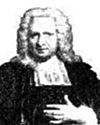John Machin facts for kids
Quick facts for kids
John Machin
|
|
|---|---|

John Machin
|
|
| Born | c. 1686 |
| Died | 9 June 1751 (aged 70–71) London, England
|
| Nationality | English |
| Known for | Machin-like formula |
| Scientific career | |
| Fields | Mathematician and astronomer |
| Institutions | Gresham College |
| Notable students | Brook Taylor |
John Machin was an important English mathematician and astronomer. He was born around 1686 and passed away on June 9, 1751. Machin is most famous for creating a special mathematical formula in 1706. This formula helped him calculate the value of pi (π) to an amazing 100 decimal places! He worked as a professor of astronomy at Gresham College in London.
Contents
John Machin's Life and Work
John Machin was a very busy and respected scientist. He held an important job as the secretary of the Royal Society for many years, from 1718 to 1747. The Royal Society is a famous group of scientists in England.
Helping Settle a Big Math Fight
In 1712, Machin was part of a special group that had to decide a big argument. This argument was between two very famous mathematicians, Gottfried Leibniz and Isaac Newton. They were arguing about who first came up with calculus, a major branch of mathematics.
Professor at Gresham College
On May 16, 1713, John Machin became a professor of astronomy at Gresham College. He took over this role from Alexander Torriano. Machin kept this job until he died in London on June 9, 1751. He was known for his excellent math skills.
Calculating Pi to 100 Places
One of Machin's greatest achievements was calculating the value of pi (π) to 100 decimal places in 1706. Pi is a number used to find the circumference and area of a circle. It starts with 3.14159... and goes on forever without repeating. Calculating so many decimal places was a huge task back then! He used a method developed by another famous astronomer, Edmond Halley.
His Writings and Discoveries
Many of John Machin's handwritten notes and papers are kept safe by the Royal Astronomical Society. In 1727, he wrote to a mathematician named William Jones. In his letter, Machin said he deserved a special reward from the government. This reward was £10,000 for improving the tables used to predict the moon's position. These tables were important for sailors to figure out their location at sea.
In 1728, John Machin was listed as one of the people who supported the creation of a very important book. This book was called the Cyclopaedia, or Universal Dictionary of Arts and Sciences. A cyclopaedia was like an early version of an encyclopedia, filled with knowledge about many different subjects.
Machin's Formula for Pi
John Machin is most famous for his special formula used to calculate pi. This formula made it much easier and faster to find many decimal places of pi.
What is Machin's Formula?
Machin's formula looks like this:
Don't worry if the math looks complicated! The important thing is that this formula was a big improvement. Before Machin, people often used a formula called the Gregory/Leibniz series. While that formula worked, it was very slow to get many decimal places of pi.
Why Machin's Formula Was Better
Machin's new formula was much faster because it "converged" more quickly. This means that each step of the calculation got closer to the true value of pi at a much faster rate. This made it a very practical way to calculate pi.
To get pi to 100 decimal places, Machin combined his formula with another mathematical tool called the Taylor series. This series helps to expand certain mathematical functions. Brook Taylor, who developed the Taylor series, was a contemporary of Machin at Cambridge University.
For a long time, even into the age of computers, Machin's formula was the main method used by people trying to calculate more and more decimal places of pi. There are also other formulas that are similar to Machin's, known as Machin-like formulae.
See also
- Gresham Professor of Astronomy


